We organise Varanasi Tours covering all places of interest: temples,ramnagar,sarnath,vindhyachal,sangam,gaya,chtrakoot,ayodhya,nainisaranya,lucknow,chunar
[tabset class=”tabset-1″]
[tabs tabname=”Varanasi – Overview”]
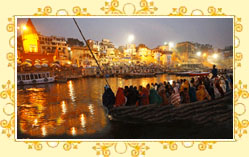
Varanasi or Kashi or Banaras is one of the oldest living cities in the world, with a continuous history dating back to more than 5,000 years. The City is situated on the western bank of River Ganges. On the north flows the Varuna and on the south flows the Assi, giving the city its official name Varanasi. Banaras is modified version of Varanasi. The city is also known as Kashi which is derived from the word Kashi (means to shine).
Kashi is the ‘original ground’ created by Shiva and Parvati. Varanasi is the microcosm of Hinduism, a city of traditional classical culture glorified by myth and legend and sanctified by religion. It has always attracted large number of Pilgrims and worshippers. To be in Varanasi is an experience in itself…. An experience in self –discovery and eternal oneness of the mind, body and soul. Mark Twain, the English author and literature, was enthralled by the legend and sanctity of Benares that he described the city as: “Banaras is older than history, older than tradition, older even than legend and looks twice as old as all of them put together”
Few Places in India are as colorful, charismatic, spiritual as the bathing Ghats lining the Ganges in Varanasi. It is considered to be one of the holiest places where Hindus come to wash their Sins. It’s a city where the rituals of life and death take place in public on the Ghats.
To every visitor, Varanasi offers a breathtaking experience. The ray of the dawn shimmers across the Ganges… the high bank, the temples and shrines along the banks …sole stirring hymns and mantras along-with the fragrance of incenses filling the air… and the refreshing dip in the holy water of Ganges. Varanasi the land where experience and discovery reach the ultimate bliss.
Time Zone: IST (UTC+5:30)
Weights Measures System: Metric
Electricity: 220V
Coordinates: 25.282°N 82.9563°E / 37.483, 126.633
Area: 1550 km² (598 SQ MI)
Elevation 80.71 meters
Average Rainfall 244 mm
Population 3,147,927 (2010)
Sex Ratio 879 Females to 1000 male
State Uttar Pradesh
Language Spoken Hindi and English
[/tabs]
[tabs tabname=”Fair & Fastivals”]
FAIRS AND FESTIVALS :Varanasi is known as Cultural Capital of India. The multitudinous vigour of the people is reflected in the colorful vibrancy of their fairs and festivals. Fairs and festivals are celebrated with traditional gaiety and fervor to invoke divine blessings as well as for the sheer joy of living. The unique festival calendar goes throughout the year, giving you the liberty to plan your tour to Varanasi India anytime and every time.. These festivals keep the age old customs and traditions alive Some of the Important festivals celeberated here are:
Makar Sankranti celeberated on 14th January every year is one of the most auspicious day for the Hindus , Millions of people take a holi dip in Ganges and pray to Lord Sun.  It is the day when the glorious Sun-God of Hindus begins its ascendancy and entry into the Northern Hemisphere. The co-relation of cosmic events with individual life and values is one of the most astounding traits of Hindu Masters. Of all the cosmic bodies Sun is the most glorious & important, thus every sun-centric cosmic event became very important spiritual, religious & cultural events. Thus from the religious point of view it is believed that on this day Sun visits the house of his son Shani- swami of Makar Rashi. These father & son do not get along nicely, but inspite of any difference between them Lord Sun makes it a point to meet his son on this day and stay at his sons place for a month. This day symbolized the importance of special relationship of father & son. It is the son who has the responsibility to carry forward his fathers dream and the continuity of the family.
It is the day when the glorious Sun-God of Hindus begins its ascendancy and entry into the Northern Hemisphere. The co-relation of cosmic events with individual life and values is one of the most astounding traits of Hindu Masters. Of all the cosmic bodies Sun is the most glorious & important, thus every sun-centric cosmic event became very important spiritual, religious & cultural events. Thus from the religious point of view it is believed that on this day Sun visits the house of his son Shani- swami of Makar Rashi. These father & son do not get along nicely, but inspite of any difference between them Lord Sun makes it a point to meet his son on this day and stay at his sons place for a month. This day symbolized the importance of special relationship of father & son. It is the son who has the responsibility to carry forward his fathers dream and the continuity of the family.
Maha Shivratri usally falls in the month of Feb-march every year.According to Hindu mythology, Shivaratri symbolizes the wedding day of Lord Shiva and Parvati.  Many however, believe, Shivaratri is the night when Lord Shiva performed the Tandava Nritya – the dance of primordial creation, preservation and destruction. Celebrating the festival in a customary manner, devotees give a ritual bath to the Lingam with the panchagavya – milk, sour milk, urine, butter and dung. Celebrations mainly takes place at night. Devotees throng Shiva temples spend ‘the Night of Lord Shiva’ by chanting verses and hymns in praise of the Lord. The festival holds special meaning for the ladies as they pray to Goddess Parvati (Gaura) the giver of suhag’ for good husbands, marital bliss and a long and prosperous married life. City Varanasi dedicated to Shiva becomes shivmay and various processions are taken out from different parts of the city. Its worth watching.
Many however, believe, Shivaratri is the night when Lord Shiva performed the Tandava Nritya – the dance of primordial creation, preservation and destruction. Celebrating the festival in a customary manner, devotees give a ritual bath to the Lingam with the panchagavya – milk, sour milk, urine, butter and dung. Celebrations mainly takes place at night. Devotees throng Shiva temples spend ‘the Night of Lord Shiva’ by chanting verses and hymns in praise of the Lord. The festival holds special meaning for the ladies as they pray to Goddess Parvati (Gaura) the giver of suhag’ for good husbands, marital bliss and a long and prosperous married life. City Varanasi dedicated to Shiva becomes shivmay and various processions are taken out from different parts of the city. Its worth watching.
Holi – the festival of colours is one of the most ancient festivals of India and bears religious, cultural and literary significance as well! It’s the time to come closer in the spirit of renewal and it’s also a time symbolizing the triumph of all Good over all Evil. T here are a few myths and legends to which this Holi festival can be traced to. But the differences of the narratives notwithstanding, the all-encompassing spirit of goodness and virtue is the common thread in all these legends behind the festival of Holi.
here are a few myths and legends to which this Holi festival can be traced to. But the differences of the narratives notwithstanding, the all-encompassing spirit of goodness and virtue is the common thread in all these legends behind the festival of Holi.
Holi heralds the coming of the bountiful springtime and the end of the harsh winter months. Thus the spirit of renewal, happiness and merrymaking is at the heart of the Holi celebrations. It’s celebrated on a full moon day in the month of ‘Phalgun’ (END OF FEB OR EARLY MARCH) .The festivities and rituals kick off the night before when the bonfires are lit up to symbolize the warding off of all evil from this world.
Dhrupad Mela. Usually celeberated in the month of March a five  day long music festival is organised on the Tulsi Ghats. During the five days renowned artists from all over the country perform Dhrupad here. This festival is one of the major tourist attractions of Varanasi as music lovers from not only the country but from around the world come here to take part or be a part of the musical extravaganza.
day long music festival is organised on the Tulsi Ghats. During the five days renowned artists from all over the country perform Dhrupad here. This festival is one of the major tourist attractions of Varanasi as music lovers from not only the country but from around the world come here to take part or be a part of the musical extravaganza.
Sankat Mochan Sangeet Samaroh Galaxy of Indian Classical music performs for five nights at this festival (April-May)
Ganga Mahotsav a Cultural performances on the river front at Rajendra Prasad Ghat (October-November)
[/tabs]
[tabs tabname=”Local Excursions”]
River Front – The Ghats of Varanasi
The great river banks at Varanasi, built high with eighteenth and nineteenth –century pavilions and palaces, temples and terraces are lined with an endless chain of stone steps-the ghats-progressing along the whole of water front. Each of the ghats is marked with a lingam big or small and occupies its own place in the religious geography of the city. Some of them have crumbled over the years and others continue to thrive with early morning bathers, Brahmin priests offering prayers and people practicing yoga and meditation.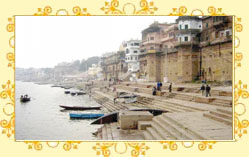
A boat ride on a private hand rowing boat from Dasaswamedh ghat early in the morning is the best way to watch the sunrise and life around the ghats. Some of the important ghats which you shall see are Dasaswamedh ghat, kedar ghat harishchandra ghat, manmandir ghat, manikarnika ghat (cremation ghat), panchganga ghat.
Temples of Varanasi
Vishwanath Temple or the golden temple is dedicated to Lord Shiva, the presiding deity of the city. Varanasi is said to be the point at which the first ‘Jyotir lingam’, the fiery pillar of light by which Shiva manifested his supremacy over other gods, broke through the earth’s crust and feared the heavens. And even the gaga, the Shilling installed in the temple remains the devotional focus of Varanasi. Close by is also the Alamgir Mosque which is blend of Hindu and Muslim type of Architecture. Some say that the mosque was constructed by destroying the original Vishwanath temple and the present temple was constructed by Queen Ahilya Bai. Adjacent to the Golden temple is the temple of Annapurna Bhavani is dedicated to the supreme shanty(She , the being of Plenteous of food) the queen and divine mother of the three world. As the provider of substance she carries a cooking pot rather than the fearsome weapons borne by her horric forms of Durga or Kali.
The other important temples are the New Vishwanath temple at the Banaras Hindu University Campus dedicated to Shiva. Sankat Mochan Temple dedicated to hanuman is in the southern part of the city. Sankat Mochan means the one who removes the suffering, The temple was founded by Goswami Tulsi Das the author of the Hindu epic Ramayana. Tulsi manas temple constructed of white marble is another famous temple of Varanasi it is dedicated to Lord Rama .It was constructed in the year 1964 at the same spot where goswami Tulsidas wrote the famous Ramacharitmanas. Durga Temple or the monkey temple (due to presence of monkey) is dedicated to goddess Durga – wife of Shiva and the Goddess of power. It was constructed in the 18th Century and is said that goddess appeared in the temple of her own (i.e. it was not made by any individual).
Bharat mata Temple or the mother India Temple is dedicated to mother India and is situated in the university Campus of Mahatma Gandhi Kashi Vidyapeeth. There is no statue inside the temple but a relief map of Undivided India carved from a single piece of marble. Temple represents unity in diversity.
Kal Bhairav Temple is another ancient temple of Varanasi and is supposed to be the kotwal of Varanasi. It is believed that without the permission of Kal bhairav no one can stay in Varanasi.
Sarnath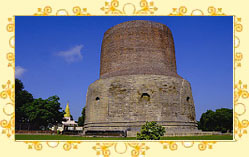
Sarnath is approx 10 kms from Varanasi; it is the place where Buddha preached his first sermons at the sight Dhameek Stupa. There is also the mahabodhi temple and several monasteries. Sarnath museum (closed on Friday) is worth watching it houses several antique stone pieces/heads of Buddha. Our national emblem (the lion head) comes from this museum.
Bharat Kala Bhavan – Art Gallery & Banaras Hindu University.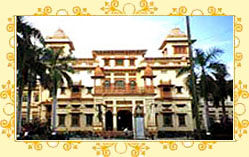
Bharat Kala Bhavan is situated inside Banaras Hindu University. It is an art and Architecture museum and houses some of the finest miniature paintings, Hindu and Buddhist sculptures and materials of archeological importance. It was established in the year 1920. BHU is one of the largest residential universities of the world. It was founded by Mahamana Madan Mohan Malvia. The university imparts education in all fields of education and has contributed in a great deal in the growth of the nation.
Ramnagar fort
The Ramnagar fort is approx 14 km. from Varanasi and is situated on the opposite bank of river Ganges. It is the ancestral home of the Maharaja of Banaras and was built by Maharaja Balwant Singh in the eighteenth century. The fort is built in red sandstone.The Ramnagar fort has a temple and 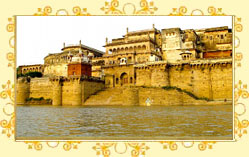 a museum within the grounds. The temple is dedicated to Ved Vyasa, who wrote the great Indian epic Mahabharata. The fort houses a museum displaying the Royal collection which includes vintage Cars, Royal palkies, an armory of swords and old guns, ivory work and antique clocks. An interesting array of ornate palanquins, gold-plated howdahs and weapons are some of the artifacts on display in the Ramnagar fort-palace museum.
a museum within the grounds. The temple is dedicated to Ved Vyasa, who wrote the great Indian epic Mahabharata. The fort houses a museum displaying the Royal collection which includes vintage Cars, Royal palkies, an armory of swords and old guns, ivory work and antique clocks. An interesting array of ornate palanquins, gold-plated howdahs and weapons are some of the artifacts on display in the Ramnagar fort-palace museum.
There is also a Durga Temple and Chhinnamastika Temple and a temple of Dakshin Mukhi Hanuman. The most interesting is that inside the giant walls of the Ramnagar fort-palace, there is a big clock. This clock not only displays year, month, week and day but also astronomical facts about the sun, moon and constellation of stars.
Ganga Aarti
Ganga Aarti (ritual of prayer) at Dasaswamedh ghat. Aarti is a Hindu ritual, in which light from wicks soaked in ghee (purified butter) or camphor is offered and 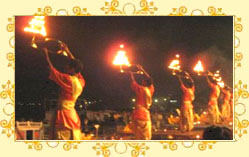 traditional Hindu devotional song is sung during the ritual. This is particularly interesting to see in Varanasi where elaborate Ganga Aarti at Dasaswamedh ghat is held every evening, just after sunset. As the aarti begins, young priests take their positions at the platform and begin swinging the lamp to the tune of chants.
traditional Hindu devotional song is sung during the ritual. This is particularly interesting to see in Varanasi where elaborate Ganga Aarti at Dasaswamedh ghat is held every evening, just after sunset. As the aarti begins, young priests take their positions at the platform and begin swinging the lamp to the tune of chants.
Incenses are burnt, hundreds of floating candles, flowers, and food are released into the Ganges Dasaswamedh ghat becomes a hub of activity, with people sitting and waiting for the aarti, buying flowers and other things from nearby shops or performing pooja.
[/tabs]
[tabs tabname=”Add Ons”]
Experience Hindu Rituals in a Temple
We also organize Rudrabhishek experience for your clients in a Shiva Temple. Rudrabhishek is combination of two words (Rudra + Abhishek) Rudra means Anger and Abhishek means – Pouring of Pure Ghee /milk / honey /gangajal /juice of sugar cane on the shivling. The said activity done with chanting of Mantra is called “Rudrabhishek”. It is done to appease the Great God Shiva to fulfill our wishes.
Visit of NGO /Mother Teresa Home /Orphanage
We organize visit to Kiran Centre (www.kiranvillage-org) or SOS village (http://www.sos-childrensvillages.org) or Nirman (www. Nirman.info). Visit to Mother Teresa Home or an orphanage can also be organized for your clients. We are also associated with Shaman Trust (www. shamantrust.org) who is engaged in wildlife conservation, awareness programs and cultural exchange programs.
All these centers expect some donation and prior appointment to be taken from them. Photography can be done only permission from the Centre.
Yoga
Varanasi has been a great center of Indian philosophy, spiritualism, Aired, Yoga and mysticism. Yoga is a way of balancing and harmonizing the body, mind and emotions. Yoga at most of the places is restricted to the students and members only however one can have private classes on requests.
Astrology at Varanasi
Varanasi is a center of education and learning for centuries Scholars, intellectuals, philosophers, mystics and saints from all over the world have been coming here to gain knowledge. Varanasi is more famous for Vedic education and astrology (jyotis). On request we arrange meeting with astrologers.
Dinning experience with a Indian Family
On request we arrange dinner with a local family which will help guest to understand the culture in a better way.
Visit to Vedic school / Music School
On request we can arrange visit to vedic school or a music school and the Guests can interact with Students /Teachers.
Heritage walk in the city
We organise walking tours in the old part of the city /river side
[/tabs]
[tabs tabname=”Out Station Excursions”]
JAUNPUR 60 kms from Varanasi was founded in the 14th century by Feroz Shah Tuglaq to perpetuate the memory of his cousin Sultan Mohammad whose real name was Jauna. Later, around 1394 AD, it became the centre of the independent Sharquie kingdom of Jaunpur founded by Malik Sarvar. They were great patrons of art and architecture and constructed many fine tombs, mosques and madarsas. These have distinctive styles which bear influences of later Tughlaq architecture.
Jaunpur was also an important centre of Islamic studies. While its architectural heritage speaks of its illustrious past, the city is known today for its Jasmine oil, tobacco leaves, reddish and imarti, a sweetmeat Founded in the 14th century by Feroz Shah Tuglaq to perpetuate the memory of his cousin Sultan Mohammad (Jauna), Jaunpur became the centre of the independent Sharquie kingdom of Jaunpur in 1394
Places of Interest in Jaunpur
Atala Masjid – This mosque represents the earliest and finest example of Sharquie architecture, and conforms to the general plan of an orthodox mosque. The construction of the masjid started in 1377 and was completed in 1408. Its most distinguishing feature is the original treatment of the facade of its prayer-hall composed of three large ornamental archways, the central one soaring to 23m. Jami Masjid – This is last and largest mosque of Jaunpur, the Jami Masjid was built by Hussain Shah between 1458-78. In plan and design it is a larger version of the Atala Mosque. The imposing structure, raised on a high plinth, encloses a courtyard 66m by 64.5m. A lofty dome tops the interior of the prayer hall.
Lal Darwaza Masjid: The construction of this mosque is said to have taken place around 1450 and is attributed to Bibi Raji, the queen of Sultan Mahmud Shah. It is built on a much smaller area than the Attala Masjid. Shahi Bridge: Constructed by Munim Khan in 1568, this picturesque old bridge spans the Gomti River.
CHUNAR is situated in the Vindhya Range at a distance of 42 KMS from Varanasi on the right bank of holy Ganga. Saint Bhartrihari took live Samadhi inside the fort. Sonwa Mandap, Sun clock and a huge well are some of the attractions inside the fort. The fort offers a splendid view of the river Ganga. The historical Chunar fort became important for its association with the Mughal king, Babar and later Shershah Suri, who got the possession of the fort by marrying the wife of Taj Khan Sarang-Khani, the Governor of Ibrahim Lodi. In 1531 AD Humayun made an unsuccessful effort to capture this fort but later in 1574AD, Akbar the great captured this fort and since that very time it remained under the Mughals up to 1772AD. In the year 1772AD the East India Company captured the Chunar fort.
SITA SAMAHIT STHAL or The holy place of SITAMARHI is situated almost midway between the two religiously important cities of Allahabad and Varanasi. The great Indian epic, the Ramayana written by Maharishi Valmiki talks extensively about Lord Rama & his consort Sita’s association with this place. Valmikiji very delicately defined the noble character of Maa Sita, her sincerity, devotion & sacrifice which made her an ideal woman. Her steadfastness to her beliefs was remarkable even though her life was full of pathos, agony and suffering. It was at Sita Marhi where she descended into the lap of Mother Earth. A temple dedicated to Maa Sita has been constructed here. The temple also provides accommodation and one can experience the Ashram life by staying here for an overnight.
VINDHYACHAL – an important Hindu pilgrimage centre is situated at a distance of approx 70 KMS from Varanasi .It’s one of the most important Shaktipeeths and is believed that Goddess Durga had established herself here after having killed the demon king Mahishasura. Thus, Goddess Durga is also known by the name of Vindhyavasini in this area. Other important sites are Sitakund , it is said When Sri Ram, Lakshman, & Sita were returning to Ayodhya after exile of 14 years, Sita became verythirsty and Lakshman pierced an arrow and immediately a fountain of water came out. In memory of Ram, Sita and Lakshman and Goddess Durga a temple was constructed. One can quench his/her thirst here at the Sitakund. After climbing 48 steps to the Sita Kund the track leads to another low hillock, where the Ashtabhuja Temple is situated. Near to the Ashtabhuja temple, there is another cave temple with a narrow path. The cave roof is so low that one has to bow down to have a glimpse of the subterranean Goddess Kali. Besides these temples there are many more temples at Vindhyachal. There are also the Brahmakund and Agastyakund whose waters are very sacred and it is believed that bathing in these water can relieve one of his/her sins.
ALLAHABAD Allahabad is located at the confluence of Ganges, Yamuna and Saraswati, popularly known as Triveni Sangam. The district is famous for its rich cultural heritage and religious importance. This culturally rich district of Allahabad is a favorite destination for pilgrims. Millions of pilgrims come to visit the Kumbh Mela of Allahabad which is held after a gap of twelve years. Other tourist attractions are Magnificent Allahabad Fort (under Indian army and one requires special permission to enter the premises) built by Emperor Akbar in 1583 AD. Its three gateways are flanked by high towers. Patalpuri Temple set inside the fort and is an underground temple, it also houses the Ashoka Pillar.This antique piece is 10.6 M tall and dates back to 232 B.C.. Hanuman Temple The unique temple is the only one of its kind housing an idol of Hanuman in a reclining posture. It is situated near the sangam. Mankameshwar Temple Among the famous Shiv temples in Allahabad is set on the banks of Yamuna, near the Saraswati Ghat. Anand Bhawan -the former home of the Nehru family which saw all the events of the freedom struggle , now houses a museum, displaying the memorabilia of the Nehru family in the main building. All Saints Cathedral Sir William Emerson designed this fine cathedral more than a century ago. The structure houses some exquisite glass murals. It is dedicated to the memory of people of all ages and places, who have kept their faith in the Almighty. Khusru Bagh This beautiful garden houses the tomb of Khusru, son of Salim and Shah Begum.
AYODHYA is situated on the right bank of the river Ghagra or Saryu, as it is called within sacred precincts. Just 6 km from Faizabad, Ayodhya is a popular pilgrim centre. This town is closely associated with Lord Rama, the seventh incarnation of Lord Vishnu. The ancient city of Ayodhya, according to the Ramayana, was founded by Manu, the law-giver of the Hindu. For centuries, it was the capital of the descendants of the Surya dynasty of which Lord Rama was the most celebrated king.
Ayodhya during ancient times was known as Kaushaldesa. Skand and some other Puranas rank Ayodhya as one of the seven most sacred cities of India. It was the venue of many an event in Hindu mythology, today pre-eminently a temple town, Ayodhya is also famous for its close association with the epic Ramayana. It is a city of immense antiquity full of historical significance and sacred temples. The Atharvaveda described Ayodhya as `a city built by Gods and being prosperous as paradise itself’. Ayodhya is pre-eminently a city of temples yet, all places of worship here, are not only of Hindu religion. At Ayodhya several religions have grown and prospered simultaneously and also at different periods of time in the past.
CHANDRAPRABHA WILDLIFE SANCTUARY 70 km, Varanasi are the forests of Chandrapha. Chandra Prabha Wildlife Sanctuary . once home to Asiatic Lions, but their numbers dwindled and today it is difficult to find a trace of these lions. But Chinkara and Panther is the highlight of the sanctuary. It is home to a number of animals and some of the animals you come across in Chandra Prabha Sanctuary include sambhar, nilgai, blackbucks, porcupine and wild boar. You can also see python and gharial in the sanctuary. The sanctuary is also home to a number of birds and you can see at least 150 species of birds. These forests nestle within them the Rajdari and Devdari waterfalls. A beautiful secluded place for a relaxed outing or a picnic.
KAIMOOR WILDLIFE SANCTUARY 130 km. from Varanasi. Spread over an area of 500 sq. km., the Sanctuary has a veriety of wildlife. The Mukha waterfall is a tourist attraction.
[/tabs]
[/tabset]